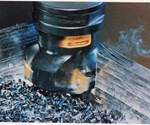Eliminate Chatter and Solve Finish Problems
Eliminating chatter is a great way to improve surface finish when performing CNC milling. Okuma's Machining Navi M-i detects chatter and automatically adjusts spindle speed to eliminate chatter, thus improving surface finish. This is a terrific tool for the mold/die industry.
Surface finish problems can be profit killers in the moldmaking shop. One of the most common causes is chatter created by vibration in the CNC machine tool cutting process. This can lead to higher costs, delayed deliveries and even lost orders due to poor quality. In addition, vibration can cause uneven tool wear, resulting in poor surface finish, geometry inconsistencies and reduced tool life.
Chatter is caused by the inherent natural frequency of the cutting tool. It can be triggered by many process conditions: toolholding, cutter tooling, part fixturing and machine conditions. Typically operators try to combat chatter by combining multiple solutions, but some of these may impossible to implement due to part geometries or machine limitations. Fortunately, there is new technology available today that can eliminate chatter from your cutting processes.
Related Content
-
How to Eliminate Chatter
Here are techniques commonly used to combat chatter and guidelines to establish a foundation for optimizing the moldmaking process.
-
Speed, Productivity Gains and High Uptime Ease Decision for Second Five-Axis Machine
Byrne Tool + Design reduced setups and gained speed and productivity thanks to fast, accurate and compact five-axis CNC machining centers.
-
How to Analyze and Optimize Cutting Conditions to Reduce Cycle Time
Plastic injection mold design and manufacturing company puts NC program optimization software module to the test. The results were surprising.












